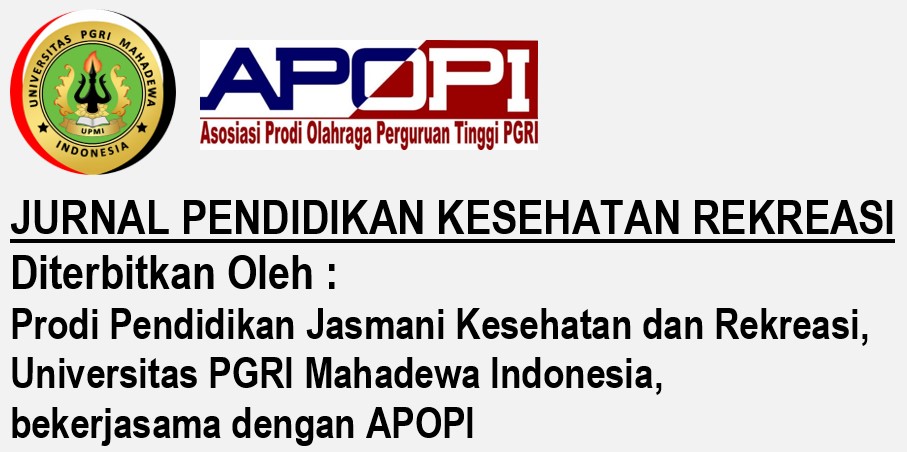Literature Review : Bagaimana Kinerja Latihan Core Stability dalam Meningkatkan Keseimbangan Tubuh Individu Down Syndrome?
DOI:
https://doi.org/10.5281/zenodo.7504864Keywords:
down syndrome, keseimbangan, motorik, core stabilityAbstract
Individu down syndrome mengalami masalah keseimbangan tubuh yang disebabkan oleh gangguan motorik yang mengakibatkan terjadinya masalah pada sistem muskuloskeletal bagian inti tubuh. Ketika terjadi ketidakstabilan pada bagian inti tubuh, maka akan terjadi peningkatan goyangan postural yang mengakibatkan ketidakseimbangan tubuh. Penelitian ini bertujuan mengetahui kinerja dari latihan stabilitas inti dalam meningkatkan keseimbangan individu down syndrome. Menggunakan metode penelitian literature review dengan sumber utama jurnal hasil penelitian dari tahun 2015-2022. Hasil tinjauan literatur menunjukkan latihan stabilitas inti mampu memberikan perbaikan keseimbangan tubuh statis dan dinamis individu down syndrome dengan program latihan selama 8-12 minggu, frekuensi 3 kali/minggu, dan durasi setiap latihan 30-60 menit. Terjadinya peningkatan keseimbangan tubuh, karena latihan core stability menguatkan dan memperbaiki pengorganisasian antara otot bagian inti dengan otot ekstremitas, otot inti berfungsi dalam mentransfer kekuatan antara ekstremitas atas dan bawah dari sistem kontrol postural yang secara permanen diperlukan untuk mempertahankan dan memindahkan pusat massa di atas dasar penyangga dalam menjaga keseimbangan. Latihan core stability dapat dimasukkan menjadi salah satu latihan pada program pelatihan untuk individu down syndrome dan menambahkan latihan yang dapat mengaktifkan sistem somatosensori akan memaksimalkan kinerja meraih keseimbangan tubuh.
Downloads
References
Abdurachman., Krismashogi, D., Farindra, I., & Rambung, E. (2016). Indahnya Seirama Kinesiology Dalam Anatomi. Malang: Inteligensia Media. Retrieved from https://repository.unair.ac.id/84519/
Abhilash, P. V., Sudeep, S., & Anjana, K. (2021). Relationship Between Core Endurance and Dynamic Balance in Professional Basketball Players: A Pilot Study. International Journal of Physical Education, Sports and Health, 8(4), 1-5. Retrieved from https://www.kheljournal.com/archives/2021/vol8issue4/PartA/8-3-74-346.pdf
Adi, I. N. A. N., Pramita, I., Vitalistyawati, L. P. A. (2022). Pengaruh Permainan Tradisional Engklek terhadap Keseimbangan Statis dan Keseimbangan Dinamis pada Anak-Anak Usia 6-12 Tahun di Lingkungan Padang Keling Kelurahan Banyuning Buleleng Bali. Jurnal Pendidikan Kesehatan Rekreasi, 8(1), 56-63. https://doi.org/10.5281/zenodo.5813938
Aly, S. M., & Abonour, A. A. (2016). Effect of Core Stability Exercise on Postural Stability in Children with Down Syndrome. International Journal of Medical Research & Health Sciences, 5(10), 213-222. Retrieved from https://www.ijmrhs.com/medical-research/effect-of-core-stability-exercise-on-postural-stability-in-children-with-downsyndrome.pdf
Alsakhaw, R. S., & Elshafey, M. A. (2019). Effect of Core Stability Exercises and Treadmill Training on Balance in Children with Down Syndrome: Randomized Controlled Trial. Advances in Therapy, 36(9), 2364-2373. https://doi.org/10.1007/s12325-019-01024-2
Efraimidou, V., Sidiropoulou. M., Giagazoglou, P., Proios, M., Tsimaras, V., & Orologas, A. (2016). The Effects of A Music and Movement Program on Gait, Balance and Psychological Parametres of Adults with Cerebral Palsy. International Journal of Special Education, 31(2), 1-17. https://doi.org/10.7752/jpes.2016.04217
Ghaeeni, S., Bahari, Z., & Khazaei, A. A. (2015). Effect of Core Stability Training on Static Balance of the Children with Down Syndrome. Physical Treatments, 5(1), 49-54. Retrieved from https://ptj.uswr.ac.ir/article-1-232-en.pdf
Gheitasi, M., Bayattork, M., Miri, H., & Afshar, H. (2019). Comparing the Effect of Suspended and Non-Suspended Core Stability Exercises on Static and Dynamic Balance and Muscular Endurance in Young Males With Down Syndrome. Physical Treatments, 9(3), 153-160. http://dx.doi.org/10.32598/ptj.9.3.153
Giustino, V., Messina, G., Alesi, M., Mantia, L. L., Palma, A., & Battaglia, G. (2021). Study of Postural Control and Body Balance in Subjects with Down Syndrome. Human Movement. 22(1), 66–71. Retrieved from https://doi.org/10.5114/hm.2021.98466
Istiqomah, S., (2018). Penerapan Metode Bermain melalui Permainan Ular Tangga dalam Mengembangkan Kognitif Anak Usia 5-6 Tahun di Paud Sriwijaya Lampung Timur TP.2017/ 2018. Skripsi. Universitas Islam Negeri Raden Intan. Retrieved from http://repository.radenintan.ac.id/5119/
Jain, P. D., Nayak, A., Karnad, S. D., & Doctor, K. N. (2022). Gross Motor Dysfunction and Balance Impairments in Children and Adolescents with Down Syndrome: A Systematic Review. Clinical and Experimental Pediatrics, 65(3), 142-149. https://doi.org/10.3345/cep.2021.00479
Kim, H. I., Kim, S. W., Kim, J., Jeon, H. R., & J, D. W. (2017). Motor and Cognitive Developmental Profiles in Children with Down Syndrome. Annals of Rehabilitation Medicine, 41(1), 97-103. https://doi.org/10.5535/arm.2017.41.1.97
Lasmaida, R. (2016). Meningkatkan Keseimbangan Dinamis melalui Berjalan di Atas Garis Lurus di Tk A ABA Krajan Yogyakarta. Jurnal Pendidikan Anak Usia Dini, 736-746. Retrieved from https://adoc.pub/meningkatkan-keseimbangan-dinamis-melalui-berjalan-di-atas-g.html
Lengkana, A. S., Rahman, A. A., Alif, M. N., Mulya, G., Priana, A., & Hermawan, D. B. (2020). Static and Dynamic Balance Learning in Primary School Students. International Journal of Human Movement and Sports Sciences, 8(6), 469-476.
https://doi.org/10.13189/saj.2020.080620
Malak, R., Kostiukow, A., Krawczyk-Wasielewska, A., Mojs, E., & Samborski, W. (2015). Delays in Motor Development in Children with Down Syndrome. Medical Science Monitor, 21, 1904-1910. https://doi.org/10.12659/MSM.893377
Manso, A., Ganança, M. M., & Caovilla, H. H. (2016). Vestibular Rehabilitation with Visual Stimuli in Peripheral Vestibular Disorders. Brazilian Journal of Otorhinolaryngology, 82(2), 232-241. https://doi.org/10.1016/j.bjorl.2015.05.019
Olchowik, G., Tomaszewski, M., Olejarz, P., Warchol, J., Różańska-Boczula, M., Maciejewski, R. (2015). The Human Balance System and Gender. Acta of Bioengineering and Biomechanics, 17(1), 69-74. https://doi.org/10.5277/ABB-00002-2014-05
Ponde, K., Agrawal, R., & Chikte, N. K., (2021). Effect of Core Stabilization Exercises on Balance Performance in Older Adults. International Journal of Contemporary Medicine, 9(1), 12-17. Retrieved from https://www.ncbi.nlm.nih.gov/pmc/articles/PMC4668157/
Putri, N. P. A. M. S., Sena, I. G. A., & Daryono. (2022). Perbaikan Kemampuan Keseimbangan Dinamis dengan Core Stability Exercise pada Penari Hip Hop Ekstrakurikuler di SMA N 1 Sukawati. Jurnal Pendidikan Kesehatan Rekreasi, 8(1), 119-126. https://doi.org/10.5281/zenodo.5855112
Rahayu, D. I., & Sunardi. (2018). The Effectiveness of Straight Line Walk Application Used on Straight-Walking Skills for Blind Students. Journal of ICSAR, 2(2), 148-152. http://dx.doi.org/10.17977/um005v2i22018p148
Riskesdas Kementerian Kesehatan RI. (2018). Hasil Utama Riset Kesehatan Dasar (RISKESDAS), Vol. 44, Issue 8. Retrieved from https://kesmas.kemkes.go.id/assets/upload/dir_519d41d8cd98f00/files/Hasil-riskesdas-2018_1274.pdf
Sanad, D. A., Draz, A. H., & Hegazy, R. G. (2022). Effect of Core Stability Exercises Program on Walking Performance in Children with Diplegic Cerebral Palsy: A Randomized Control Study. Current Pediatric Research, 26(1), 119-1204. https://doi.org/10.35841/0971-9032.26.1.1198-1204
Symeonidou, E. R., & Ferris, D. P. (2022). Intermittent Visual Occlusions Increase Balance Training Effectiveness. Frontiers in Human Neuroscience, 16, 1-6. https://doi.org/10.3389/fnhum.2022.748930
Szafraniec1, R., Barańska, J., & Kuczyński, M. (2018). Acute Effects of Core Stability Exercises on Balance Control. Acta of Bioengineering and Biomechanics, 20(3), 145-151. https://doi.org/10.5277/ABB-01178-2018-02
Trinova, Z. (2012). Hakikat Belajar dan Bermain Menyenangkan Bagi Peserta Didik. Jurnal Al-Ta’lim, 1(3), 209-215. Retrieved from https://journal.tarbiyahiainib.ac.id/index.php/attalim/article/view/55
Van den Heuvel, M. R. C., van Wegen, E. E. H., de Goede, C. J. T., Burgers-Bots, I. A. L., Beek, P. J., Daffertshofer, A., & Kwakkel, G. (2013). The Effects of Augmented Visual Feedback During Balance Training in Parkinson’s Disease: Study Design of A Randomized Clinical Trial. BioMed Central Neurology, 13(137), 1-9. Retrieved from http://www.biomedcentral.com/1471-2377/13/137
Varma, K., & Gokhale, P. (2021). Assessment of Static and Dynamic Balance in Swimmers. International Journal of Health Sciences and Research, 11(8), 202-210. https://doi.org/10.52403/ijhsr.20210830
Young, A. J., Silliman-French, L., & Crawford, L. (2017). Yoga for young children with down syndrome. Palaestra, 31(3), 1-25. Retrieved from https://js.sagamorepub.com/palaestra/article/view/8586
Zhou, Z., Zhou, R., Wei, W., Rongsheng Luan, R., & Li, K. (2021). Effects of Music-Based Movement Therapy on Motor Function, Balance, Gait, Mental Health, and Quality of Life for Patients with Parkinson’s Disease: A Systematic Review and Meta-Analysis. Clinical Rehabilitation, 1-15. https://doi.org/10.1177/0269215521990526
Zulfiqar, H., Hafiz Muneeb Ur Rehman, Razzaq, A., Zaib Un Nisa, Maryam Hina, Bashir, H. ., Saeed, H. ., & Ashraf, N. us S. . (2022). Effect Of Core Stability Exercises and Balance Training in Postural Control Among Children with Down Syndrome: Stability Exercises and Balance Training in Postural Control Among Children. Pakistan BioMedical Journal, 5(7), 18–22. https://doi.org/10.54393/pbmj.v5i7.392
Downloads
Published
How to Cite
Issue
Section
License
Copyright (c) 2023 Tama Anugrah, Bernadeta Suhartini, Yustinus Sukarmin, Nurhayati Simatupang

This work is licensed under a Creative Commons Attribution-NonCommercial-ShareAlike 4.0 International License.
Jurnal Pendidikan Kesehatan Rekreasi is published under the terms of Creative Commons Attribution 4.0 International License / CC BY NC SA 4.0. This license permits others to copy, distribute, modify, and create derivative works for non-commercial purposes only


































